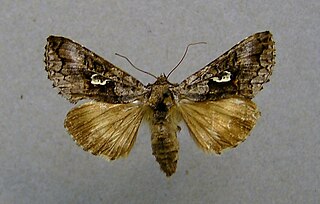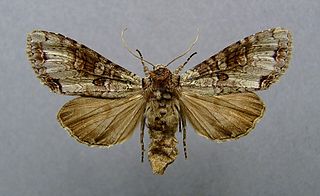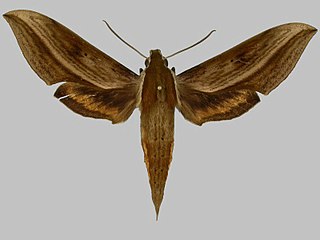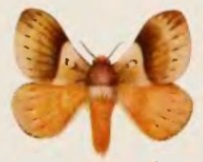
The brimstone moth is a moth of the family Geometridae. The species was first described by Carl Linnaeus in his 1758 10th edition of Systema Naturae. It should not be confused with the brimstone butterfly Gonepteryx rhamni.

Scotopteryx chenopodiata, the shaded broad-bar, is a moth of the family Geometridae. It was first described by Carl Linnaeus in his 1758 10th edition of Systema Naturae.

Syngrapha interrogationis, the scarce silver Y, is a moth of the family Noctuidae. It is found in northern part of the world including Alaska, Canada, Iceland, Europe, Siberia, the Pacific Northwest region of the United States, and Northeast Asia.

Polia hepatica, the silvery arches, is a moth of the family Noctuidae. The species was first described by Carl Alexander Clerck in 1759. It is found in temperate Europe and east across the Palearctic to Siberia and Korea. It is not present in northernmost Fennoscandia and the southern parts of the Iberian Peninsula, Italy and Greece. It is also absent from Japan.

Xylophanes damocrita is a moth of the family Sphingidae first described by Herbert Druce in 1894. It is known from Mexico.

Xylophanes rhodina is a moth of the family Sphingidae. It is known from Panama and Costa Rica.

Spilosoma alberti is a moth of the family Erebidae. It was described by Walter Rothschild in 1914. It is found on Papua New Guinea, where it is restricted to mountainous areas at high altitudes ranging from 1,200 to 2,150 meters.
Evergestis subterminalis is a moth in the family Crambidae. It was described by William Barnes and James Halliday McDunnough in 1914. It is found in western North America, where it has been recorded from west central Alberta south to Colorado, Utah and California. The habitat consists of montane meadows.
Metasia polytima is a moth in the family Crambidae. It was described by Turner in 1908. It is found in Australia, where it has been recorded from Queensland.
Ercheia amoena is a species of moth of the family Erebidae first described by Louis Beethoven Prout in 1919. It is found in New Guinea.
Pycnarmon grisealis is a moth in the family Crambidae. It was described by George Hamilton Kenrick in 1912. It is found in Papua New Guinea.
Pycnarmon mioswari is a moth in the family Crambidae. It was described by George Hamilton Kenrick in 1912. It is found in Papua New Guinea, where it has been recorded from Mioswar Island.

Tyspanodes radiata is a moth in the family Crambidae. It was described by George Hamilton Kenrick in 1907. It is found on New Guinea.
Habrona brunnea is a moth in the family Drepanidae. It is found in New Guinea and on the Moluccas. The habitat consists of mountainous areas.

Cotana dubia is a moth in the family Eupterotidae. It was described by George Thomas Bethune-Baker in 1904. It is found in New Guinea.

Cotana erectilinea is a moth in the family Eupterotidae. It was described by George Thomas Bethune-Baker in 1910. It is found in New Guinea.
Cotana pallidipascia is a moth in the family Eupterotidae. It was described by Walter Rothschild in 1917. It is found in New Guinea.

Cotana variegata is a moth in the family Eupterotidae. It was described by Walter Rothschild in 1917. It is found in New Guinea.
Papuapterote styx is a moth in the family Eupterotidae. It was described by George Thomas Bethune-Baker in 1908. It is found in New Guinea.
Giaura tetragramma is a moth in the family Nolidae. It was described by George Hampson in 1905. It is found on Fiji and on Samoa (Upolu). The wingspan is about 20 mm. The forewings are pale ashen grey, with a darker brown base and with a narrow darker external line. This is followed by a broad pale area, which is widest in the inner marginal area. Here, a very broad, slightly darker postmedian area reaches all across the wing. This area is bounded externally by a white line. There is a dark subterminal line. The hindwings are pale grey, with much very fine brownish irroration (sprinkling).










